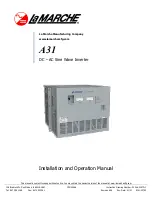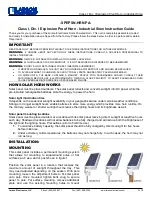
V 2.0
1. Controls and indicators
The ON/OFF switch turns the control circuit in the power inverter on and off. It does not disconnect
power from the power inverter.
When the switch is in the OFF position, the power inverter draws no current from battery. When the
switch is in the ON position but with no load, the power inverter draws less than 450 mA.
2. Battery voltage indicator
The battery voltage bar graph indicates the voltage at the input terminals of the power inverter. At low
input current, this voltage is very close to the battery voltage. At high input current, this voltage will be
lower than the battery voltage because of the voltage drop across the cable and connections.
Ideally, the voltage should remain in the green area of the bar graph. If the voltage goes into the red
area at top or bottom of the graph, inverter may shut-down.
3. Battery current indicator
The battery current bar graph indicates the current drawn from the battery by the power inverter, it will
not indicate current by other loads also connected to the battery. The indicator only displays DC volts
and amps.
For long term operation, the current should be in the green area of the bar graph. Short term operation
is possible with current in the orange area. If the current rises to the red area, the inverter will reduce its
output voltage to protect itself.
4. Over temp indicator
The over temp indicator indicates that the power inverter has shut itself down because it has become
overheated. The power inverter may overheat because it has been operated at power levels above its
rating, or because it has been installed in a location which does not allow it to dissipate heat properly.
5. Over load indicator
The over load indicator indicates that the power inverter has shut itself down because its output circuit
has been short circuited or drastically overloaded. Switch the ON/OFF to OFF, correct the fault
condition, and then switch the ON/OFF back to ON.
THINGS TO CONSIDER REGARDING THE LOAD
The 5000W inverter will operate most AC loads within its power rating. When determining whether a
microwave oven can be operated by the 5000W inverter, remember that the power commonly
advertised for microwave ovens is the cooking power (the power delivered to the food) not the power
actually consumed by the microwave oven. The microwave oven will consume 40% to 100% more than
its advertised cooking power. Check the rating sticker on the back of the oven to determine its actual
power draw. The 5000W inverter will operate small microwave ovens (0.2 to 0.3 cubic foot capacity)
that draw is about 1700 watts.






























